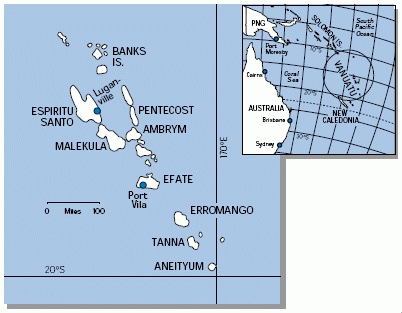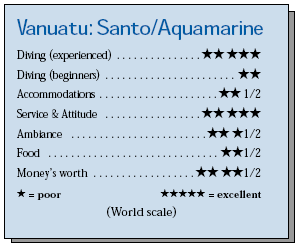Cruising Vanuatu aboard the Nai'aContents of this Issue: Cruising Vanuatu aboard the Nai'a The President and the Lady — Together Again! EQUIPMENT TIP: BLACK LIGHT DIVING Belize Coral: End of a Millennium Independent Journalism on Bonaire Is Sipadan the Shape of Things to Come? Editorial Office: Ben Davison Publisher and Editor Undercurrent 3020 Bridgeway, Suite 102 Sausalito, CA 94965 another time, another place, another exploration from the June, 2000 issue of Undercurrent
I’m not a gambling man, but I decided to make an exception. This trip demanded it, because some sites I was heading off to explore in the south Pacific nation of Vanuatu had never been dived before. The venues might be spectacular, and they might be colossal duds. I’d have to take the luck of the draw. Our boat, however, was no gamble; I’d been on the luxurious Nai’a a year earlier in Fiji (see Undercurrent, June 1999), but this time she’d be plying different waters. Our March exploratory trip was the first of three owner Rob Barrel planned among Vanuatu’s island archipelago, a three or four day sail west of Fiji but not as far (as the 737 flies) as the Solomons or Papua New Guinea, waters I’d dived before. To make our wager a little more interesting, we were gambling on a trip in cyclone season, and the Repablik Bilong Vanuatu has more cyclone exposure (3 a year on average) than any other Pacific island group -- not to mention the occasional earthquake or eruptions from two active volcanoes. Nai’a’s a comfortable craft: nine wood-paneled, a/c, ensuite cabins (all with showers with plentiful hot water) and a roomy salon with multimedia equipment and sit-down dining for 20. The upper deck’s a chaise longue sunbather’s haven, the spacious camera/photo facility well laid out. Since my last trip, they’d added an extension to the stern dive platform, providing more gear space, easier access to the inflatables, and an easy-access ladder. Surprisingly, the extension gave Nai’a another knot or two of speed, while a new, shorter mast allows more sailing. I especially appreciated the new gearing installed to cut down on the inevitable live-aboard engine noise -- a real bonus on nights we cruised among Vanuatu’s many islands (though generally dive sites were close together). Around the corner of Efate Island is Eretoka or Hat Island. Because of contrary winds, we dove the back of the Hat, using the currents to ride up and down and behind the bommies, reveling in the 80 ft. vis. Every corner was different, and the videographers had a ball. Unabashed mating cuttlefish showed off pulsating colors and changing textures while voyeuristic divers looked on. Swarms of colorful anthias, angels, butterflies, and crowds of humbugs punctuated the reef sex scene. Thriving families of yellowfin anemonefish crowded large anemones. This was world class! Since the reefs belong to the island chiefs, Kevin was indispensable in negotiating dive rights, which sometimes required treks up steep trails to a local village. One of the crew spoke some local language, although with more than 100 dialects spoken in Vanuatu, Bislama, a pidgin language, is most common. Kevin’s stolid and amicable personality was a huge asset in these sometimes labyrinthine sessions, and we never missed our dives. Nor were we shortchanged on them: well-trained coxswains driving two sturdy inflatables took us speedily to sites, so four dives a day were easy. Begin with an early breakfast of juice, coffee, toast, and cereal, take a dive and return for a hot, full breakfast (with dishes like chocolate sour cream muffins and a choice of cheese omelet or pommes allumettes), then dive again and return for a single course lunch with salad and fruit. After the afternoon dive, copious delectable snacks (lobster chunks Newburg to chocolate cookies) staved off appetites till dinner. For those who wanted to stay dry nights, evening slide shows by the traveling experts (Paul Humann on my trip, Stan Waterman on the two others) were offered in lieu of the night dive. The 8 p.m. Continental-style dinner featured multiple courses and much sharing and camaraderie among the boatful of passengers, most returning American guests along with a well-traveled German Nai’a returnee. Entrees such as beef medallions in port wine sauce or line–caught snapper in a sesame crust with black bean sauce were served with complimentary wines followed by delectable desserts that included chocolate crepes with chocolate mousse filling and mixed-berry garnish or apple and pear pie with wine sabayon sauce. Even the vegetably-inclined were taken care of. Afterwards, some guests stayed for the occasional sing by Nai’a’s Fijian crew (and one night a full meke with kava ceremony). Guest-crew relations were always excellent, and passengers were welcome to join singing and kava-drinking crew any evening. As far as we knew, nobody had ever night dived at Epi’s Lomakei Bay, so we decided to be pioneers again. I rolled into the warm and murky waters, a rich, penetrable soup of plankton. A respectable-sized grey whaler shark blew by me, undoubtedly taken by surprise, then, at 50 fsw, viz became clearer. I spotted what seemed like two small squadrons of lightning bugs. They were schools of thirty or more flashlight fish, all blinking their prehistoric signal in perfect synchrony from their triangular luminescent cheek patches. Then, in the gloom, something caught my eye. I pulled back the beam and there, suspended in the water, swimming freely, was a chambered nautilus! Waving the beam to call the other divers, I spotted another, and another. I finned toward the spherical creatures. Using the edges of the light beam to see but not chase them away, I eventually spotted a half-dozen of these normally very deep-water critters. They apparently were taking advantage of the dark night to visit shallower depths to search for food. They eyeballed me as curiously as I did them, their eyes swiveling to keep track, but they didn’t seem fearful. Tentacles extended behind, they pulsated gently to keep up with us. After 20 minutes I moved on, spotting Spanish dancers, some octopi changing colors, and a variety of crabs, shrimp, nudibranchs, and night fish. This was exploration diving at its best. At Tongoa Wall, I started in light current but wound up in a veritable Maytag, feeling like a small bird in big winds. Around me were schools of trevally and parrotfish, streams of pyramid butterflies, yellowtail fusiliers, and orange and pink anthias with masses of huge black coral trees extending downward to impenetrable depths. Closer to Luganville and just south of the massive island of Espiritu Santo were sites with fabulous reefs and islets that were accessible by day boat, some worldclass in their own right. Whitetip reef sharks were common, with occasional glimpses of other sharks and schools of cruising pelagics. The walls were festooned with large gorgonians, yellow, black and multicolored crinoids, and clouds of wreathing anthias and other small colorful fish. The shallower areas have vast forests of bright yellow staghorn coral infested by every type of smaller tropical fish species one can possibly find: families of jewel-like blue and gold-beaked filefish, sprawling anemones with big families of anemonefishes, red, blue, and pink fire corals, and countless more. Moving on to Luganville, we dived a few more times from Nai’a, then relocated to the Deco Stop Lodge in the hills above Santo. There are fancier accommodations: Bougainville Resort (with quite decent food and rooms but a few miles out of town near a dead beach); the larger, centrally located, and air-conditioned Hotel Santo, more a venue for commercial travelers, and offshore resorts at Aore and Bokissa Islands (although shark dives at Bokissa were unspectacular and unsharky, reinforcing the rumor I heard in town that the local “eco-resort” had a few presumably rogue employees who were killing sharks in the channel at night to “protect” guests using their beach). Deco Stop, however, is designed with divers in mind. It has fabulous views, cooling breezes, and a fine pool. Its hand-laid wooden buildings contain six comfortable double or twin rooms and five dorm-type accommodations, all spotless, with fridges, fans, and electric teapots. Guests ranged from younger, experienced Aussie divers sharing “backpacker” rooms to a few American guests savvy about the special diving found here. They serve meals family-style under a huge, peaked, thatched-palm roof overlaying a frame made, ingeniously enough, from a salvaged bridge! Either of Santo’s two operators will fetch you from your lodging in a van and transport you to the major dive site, the S.S. President Coolidge. Here, divers gear up on a cement platform, walk a shallow rock- and coral-strewn beach in the blazing sun, then finally drop into the water and follow a line to the deco area. Though both operations have boats, they seem to save them for other sites. I dove with both of Aquamarine’s partners (Kevin and Mayumi, Kevin’s expat Japanese wife), both from Nai’a and from their land-based operation. They gave meticulous briefings and displayed the competence that comes from indepth knowledge born of eleven years of diving the Coolidge. The Coolidge sunk in 1942 after hitting friendly mines and now rests on her port side on a sloped shore, the starboard bow shallowest at 60 fsw. More than two football- fields long, this is an immense wreck. Normally, divers are paired with experienced Coolidge guides and, after thorough briefings, led to a series of escalating deep penetrations. Some diving dilettantes merely visit briefly, but for the rest, dives begin with a peek at the huge hull and a light penetration to the promenade deck. Here, the bulkhead is really the deck, and the openwork becomes a series of skylights due to the ship’s final resting position. Old rifles, “pot” helmets, and other war paraphernalia are everywhere, as the 5,000 soldiers on board were told to leave everything when they evacuated. On the return, one looks “down” the enormous bridge, which seems like you’re looking down an endless elevator shaft! The Grail for many divers has been the first-class smoking room, where Allan Power, who had previously salvaged the ship and began offering guided diving tours of it, discovered a ceramic icon of a lady and a unicorn that had been hidden from sight (see sidebar). The Lady now resides in the first-class dining room, which lies at a similar depth of 130 fsw so divers can still acquire bragging rights. Coolidge’s dive operators have built a “deco terrace,” along which I not only encountered lionfish, anemonefish, and the like, but also saw ghost pipefish, twinspot and shrimp gobies, and other delights. Yet it’s often hard to stop and see the many denizens, because Boris, a 450-lb. Queensland grouper, rules the roost. Resembling a dark-spotted Goodyear blimp, he gets his way here. Most divers make at least one other dive here, Million Dollar Point, a name derived from the value of the construction and transport equipment the American military drove off a coral quay at the end of the war. Fifteen minutes into the dive, however, I found myself bored with looking at interminable pieces of machinery piled layers deep on one another. Vanuatu is special. I’ve dived and penetrated more wrecks in Truk, seen more soft corals and sharks in Fiji, plumbed better muck in PNG. Though the calm waters, lush islands, and drive into the jungle to nearly stone-age villages served to differentiate Vanuatu from other destinations, those yellow staghorn fields south of Santo, the wild current rides and streams of colorful fish at Tongoa, the holds, cavernous insides, and endless corridors of the Coolidge, and gargantuan Boris and the treasure booty of small rare critters at the deco stop are the memories that haunt me. Yes, indeed, my gamble paid off, many times over. — K.K. |

I want to get all the stories! Tell me how I can become an Undercurrent Online Member and get online access to all the articles of Undercurrent as well as thousands of first hand reports on dive operations world-wide
| Home | Online Members Area | My Account |
Login
|
Join
|
| Travel Index |
Dive Resort & Liveaboard Reviews
|
Featured Reports
|
Recent
Issues
|
Back Issues
|
|
Dive Gear
Index
|
Health/Safety Index
|
Environment & Misc.
Index
|
Seasonal Planner
|
Blogs
|
Free Articles
|
Book Picks
|
News
|
|
Special Offers
|
RSS
|
FAQ
|
About Us
|
Contact Us
|
Links
|
3020 Bridgeway, Ste 102, Sausalito, Ca 94965
All rights reserved.

 I boarded Nai’a in Vanuatu’s capital, Port
Vila, and promptly geared up for our first
dive in Mele Bay on Efate Island. Vanuatu
dive operator Kevin Green, a laconic,
friendly Aussie expat, accompanied us.
Kevin’s dive op, Aquamarine Divers, is located
in Santo (which is what everyone calls
the town of Luganville), and he’s an expert
on these waters. He led us into the brown and murky
bay, where several large batfish ascended like a greeting
committee. Below, a hull appeared in the gloom.
Soon, we were enjoying a multitude of fish and staring
into the dim, empty holds of a historic shipwreck, the
iron-hulled barque Star of Russia, built in 1874 by
Harland & Wolff of Belfast, better known for constructing
the RMS Titanic. The greyhound-sleek Star, nearly a football field long and 53
feet wide, lies in 110 fsw, a condominium for batfish, large scorpionfish, and a
variety of inhabitants. Other wrecks in Port Vila’s bay include MV Konanda, a 150'
freighter, the trading vessel Semle Federsen, which lies at 150 fsw, and the Qantas
S-26 Sandringham flying boat Tasman, with a wingspan of more than 100 feet, which
lies at 130 fsw. There were some fair to good reef dives here, too, and a cavern
dive at Cathedral on Mele Bay’s southern Pango peninsula.
I boarded Nai’a in Vanuatu’s capital, Port
Vila, and promptly geared up for our first
dive in Mele Bay on Efate Island. Vanuatu
dive operator Kevin Green, a laconic,
friendly Aussie expat, accompanied us.
Kevin’s dive op, Aquamarine Divers, is located
in Santo (which is what everyone calls
the town of Luganville), and he’s an expert
on these waters. He led us into the brown and murky
bay, where several large batfish ascended like a greeting
committee. Below, a hull appeared in the gloom.
Soon, we were enjoying a multitude of fish and staring
into the dim, empty holds of a historic shipwreck, the
iron-hulled barque Star of Russia, built in 1874 by
Harland & Wolff of Belfast, better known for constructing
the RMS Titanic. The greyhound-sleek Star, nearly a football field long and 53
feet wide, lies in 110 fsw, a condominium for batfish, large scorpionfish, and a
variety of inhabitants. Other wrecks in Port Vila’s bay include MV Konanda, a 150'
freighter, the trading vessel Semle Federsen, which lies at 150 fsw, and the Qantas
S-26 Sandringham flying boat Tasman, with a wingspan of more than 100 feet, which
lies at 130 fsw. There were some fair to good reef dives here, too, and a cavern
dive at Cathedral on Mele Bay’s southern Pango peninsula. After a few more dives, we headed off
to Lamen Bay on Epi Island to see its
friendly resident dugong. On our guide’s
advice, we stealthily entered the waters
so as not to frighten him. After waiting
in vain, I left for a productive muck
dive -- mud, eel grass, a variety of
cone shells, juvenile and rare fish, and
some assiduous cleaner shrimp that
jumped into my mouth when I removed my
reg to test their commitment to cleanliness.
We had lunch at the stick-walled,
thatch-roofed Paradise Sunset Bungalows
and Restaurant serving local vegetables
(especially Vanuatu’s prize yams) and
the ubiquitous south Pacific canned beef
served several ways. Our gracious host
was happy to see us; we were his first
customers of the millennium, and this
was March! He told us to see dugong we need to slap the water and make a lot of
racket to attract him. Oops!
After a few more dives, we headed off
to Lamen Bay on Epi Island to see its
friendly resident dugong. On our guide’s
advice, we stealthily entered the waters
so as not to frighten him. After waiting
in vain, I left for a productive muck
dive -- mud, eel grass, a variety of
cone shells, juvenile and rare fish, and
some assiduous cleaner shrimp that
jumped into my mouth when I removed my
reg to test their commitment to cleanliness.
We had lunch at the stick-walled,
thatch-roofed Paradise Sunset Bungalows
and Restaurant serving local vegetables
(especially Vanuatu’s prize yams) and
the ubiquitous south Pacific canned beef
served several ways. Our gracious host
was happy to see us; we were his first
customers of the millennium, and this
was March! He told us to see dugong we need to slap the water and make a lot of
racket to attract him. Oops! Diver’s Compass: Nai’a: 800-903-0272 (U.S.), 011-679-450382;
fax 011-679-450566; e-mail
Diver’s Compass: Nai’a: 800-903-0272 (U.S.), 011-679-450382;
fax 011-679-450566; e-mail 